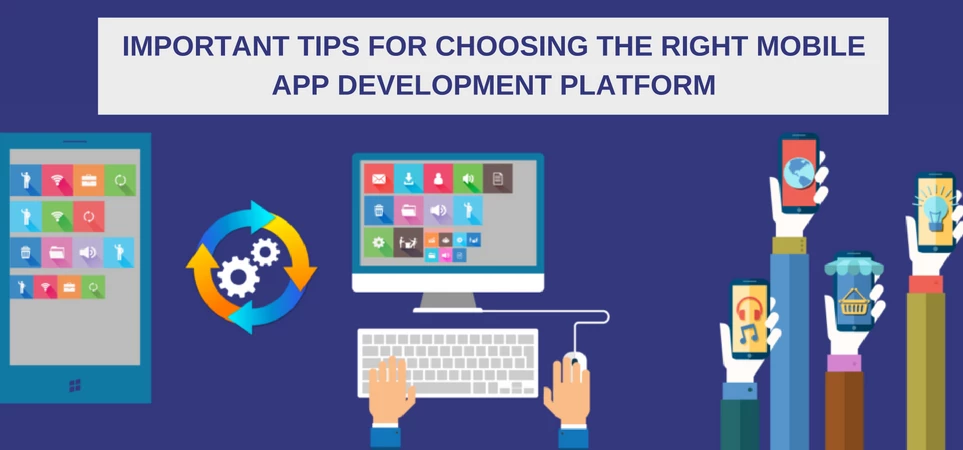
Partner Article
4 Essential Tips For Selecting Right Mobile App Development Platform For Your Enterprise
If you have landed on this blog, you are likely to make some important decisions pertaining to mobile app development. There are some questions in your mind that have led you here. Having worked with numerous clients as their professional mobile app development service partner, we know and understand that choosing the right mobile app development platform (MADP) is a difficult task. There are certain things you should keep in mind while selecting an MADP. Let’s take a look at them:
Theoretically, a mobile app development platform enables developers to build an app with varied design and coding experiences. It allows them to create development cycles that are much faster than usual. But different platforms have different limitations. While searching for an app development platform, there are certain factors you need to consider such as:
- Whether you want to deploy your app on-premises or cloud?
- Which business needs you want to address through your app?
- What kind of application do you want to develop?
- Which mobile platforms do you want to target?
- Whether your app will require any customizations, and how much?
These factors will help you draw a plan based on your basic requirements. Besides that, the following things should also be considered to ensure you make the correct choice for your project.
4 Important Things To Consider For Choosing The Right App Development Platform:
- Platform Features: While sorting through the MADP list, the first thing you need to do is identify key features of the platform. These features should allow developers to build, test, deploy, debug, host and maintain the applications throughout the entire app development lifecycle. The platform should be intuitive, easy to learn and use, and support collaborative workflows and process approvals. It should also include extensible middleware and back-end capabilities that deliver features like data storage, push notifications, and authentication.
- Mobile OS Support: The next step is to determine the mobile operating systems you want to deploy your mobile app on. While Android runs on a lot of mobile devices, enterprises often favor iOS when it comes to developing a business app. However, if you simply want to reach out to as many mobile users as possible, you may want your app to support other OSes like Windows and BlackBerry. Having said this, there are only a handful MADPs that support all the mobile operating systems. Most of them generally support Android and iOS. For the rest of the mobile systems, the MADP list will quickly reduce.
- Cross-platform Development: Choosing between the native and cross-platform app development approach is difficult. The cross-platform approach helps in developing an app that runs on multiple OSes. Developers providing Xamarin development services, write a single codebase which is used by the cross-platform tool to automatically generate code for other mobile operating systems. The cross-platform development tool should allow the apps to run efficiently on the targeted OSes and take full advantage of the native features. It should help developers to quickly create multiple versions of your application. The only drawback is, the output generated by the automatic code is not full-proof. Therefore, you must test the cross-platform capabilities thoroughly before selecting your cross-development platform.
- Deployment Method: Some MADPs offer either on premise or cloud-based services, whereas some others offer both. In the on-premises deployment, MADPs require an enormous amount of time, resources, and costs initially to purchase and implement platforms which can be beneficial for long-term as it gives total control over your infrastructure, platforms, data and security. Whereas with a cloud service, you can achieve quick and convenient access to a wide variety of platforms and technologies at low start-up costs. For deciding between the on premise and cloud-based offering, you must do a thorough analysis of costs keeping security, compliance, and auditing in mind.
MADPs are available in all shapes and sizes. They offer different features, functionalities, and support different approaches and platforms. In such a scenario, the above-listed traits will help you assess the MADPs and select the right app development platform accurately.
We’d love to hear your thoughts about the factors that should be considered while choosing the right MADP. Share your thoughts with us through the comments.
This was posted in Bdaily's Members' News section by Technoblogger .








 Navigating the property investment market
Navigating the property investment market
 Have stock markets peaked? Tune out the noise
Have stock markets peaked? Tune out the noise
 Will the Employment Rights Bill cost too much?
Will the Employment Rights Bill cost too much?
 A game-changing move for digital-first innovators
A game-changing move for digital-first innovators
 Confidence the missing ingredient for growth
Confidence the missing ingredient for growth
 Global event supercharges North East screen sector
Global event supercharges North East screen sector
 Is construction critical to Government growth plan?
Is construction critical to Government growth plan?
 Manufacturing needs context, not more software
Manufacturing needs context, not more software
 Harnessing AI and delivering social value
Harnessing AI and delivering social value
 Unlocking the North East’s collective potential
Unlocking the North East’s collective potential
 How specialist support can help your scale-up journey
How specialist support can help your scale-up journey
 The changing shape of the rental landscape
The changing shape of the rental landscape